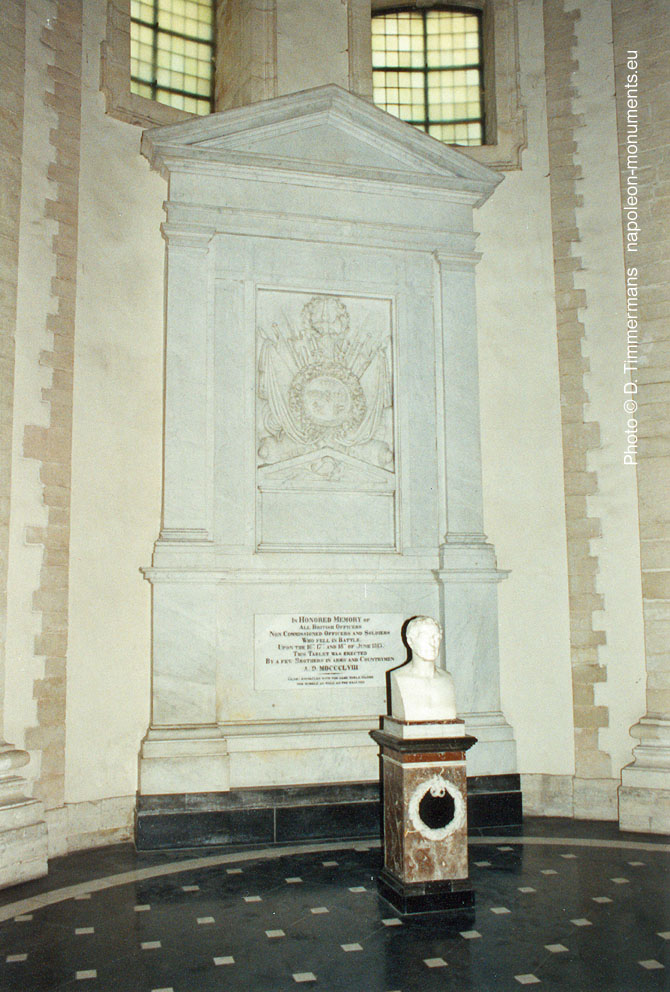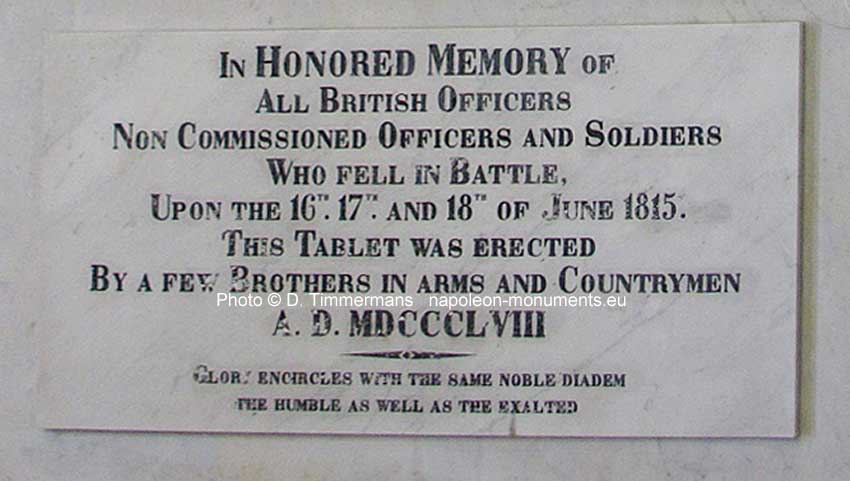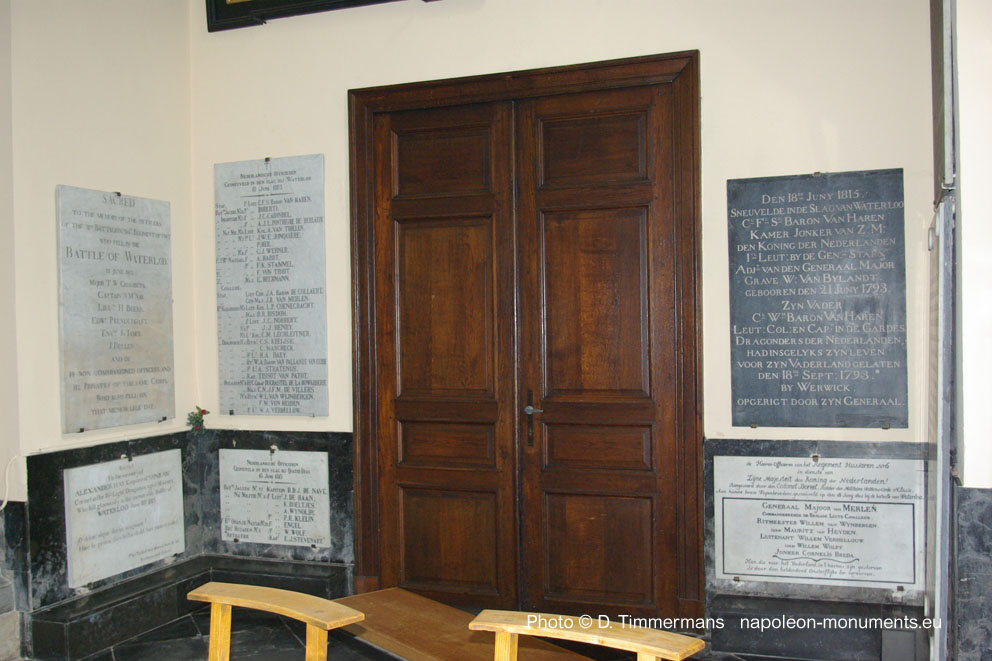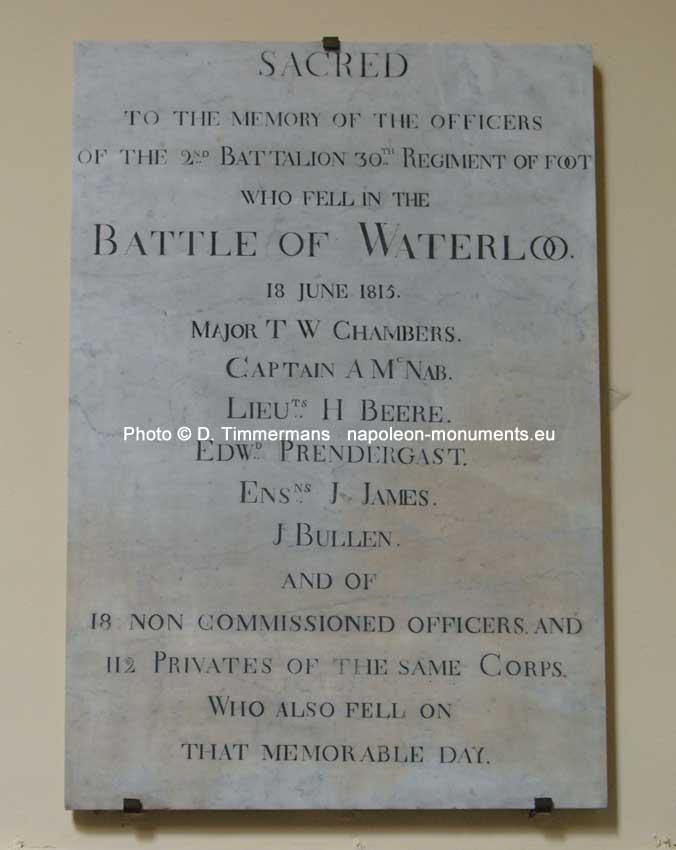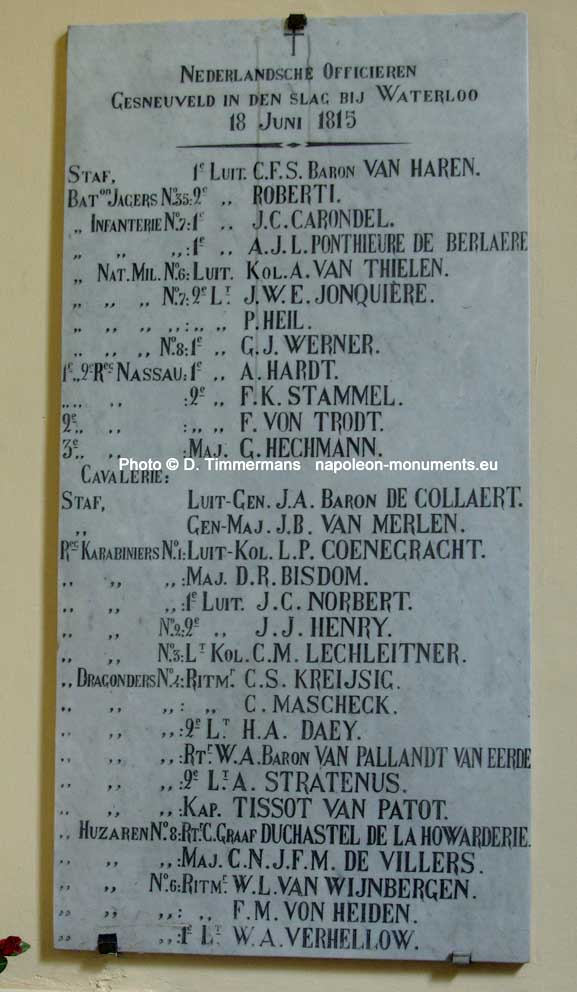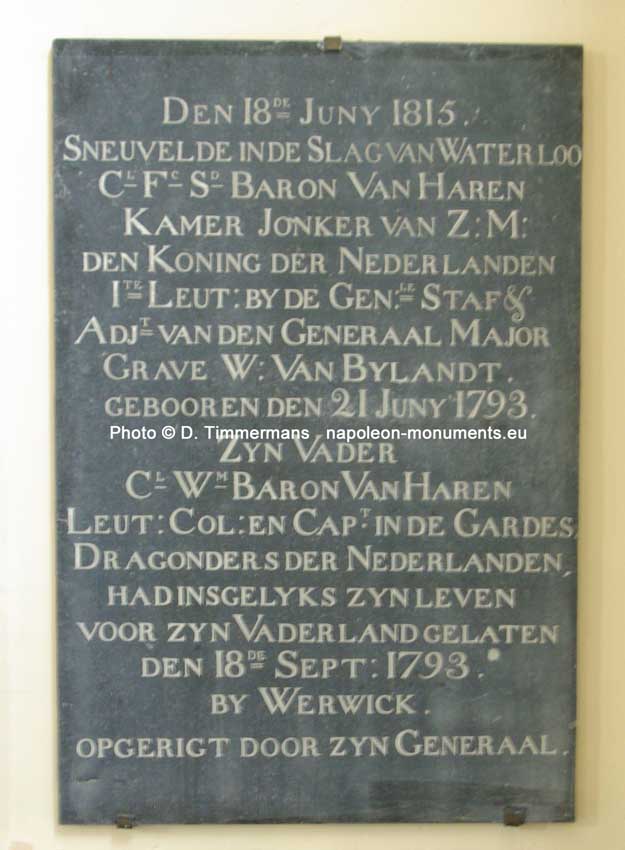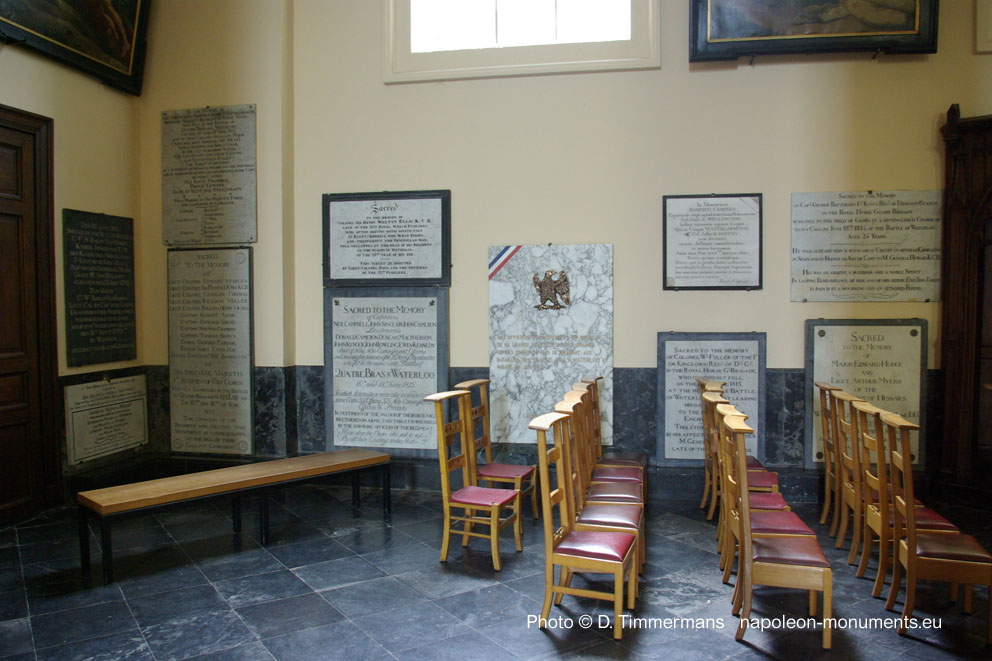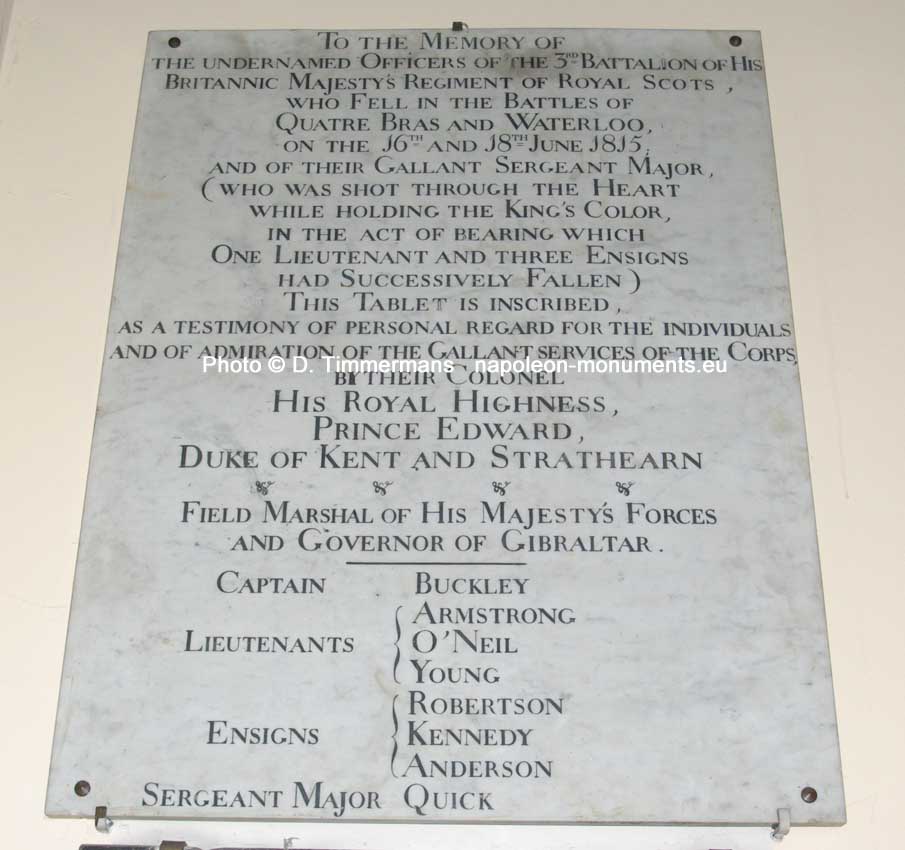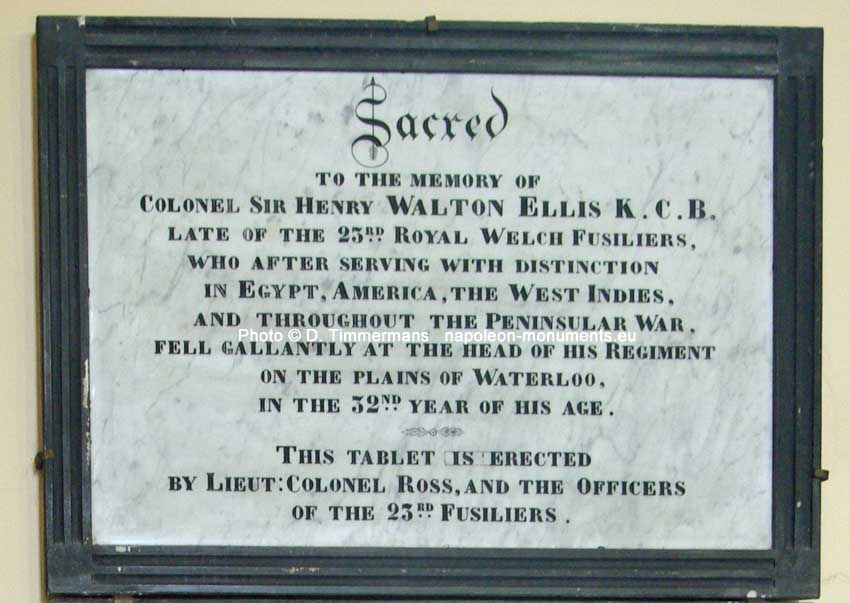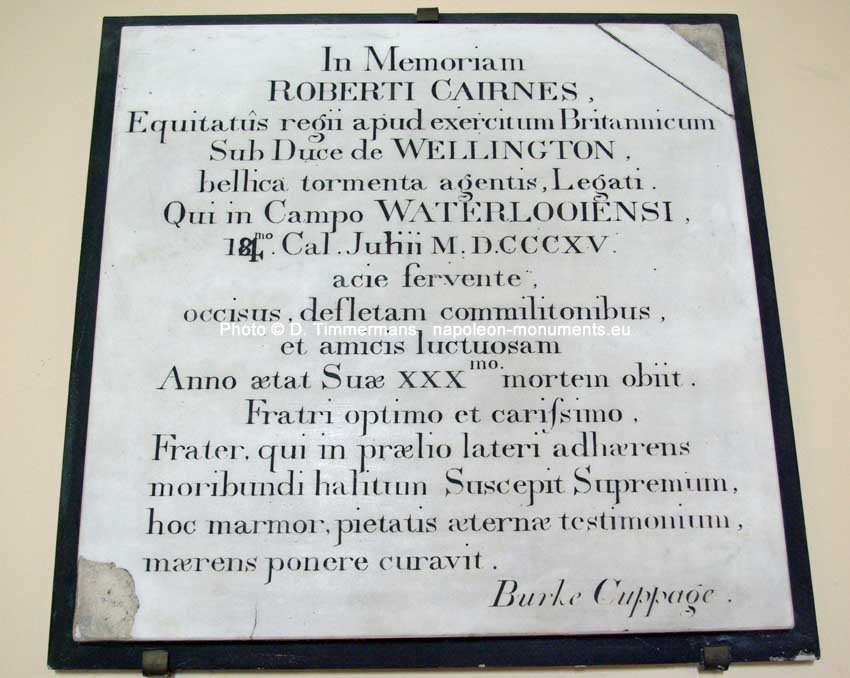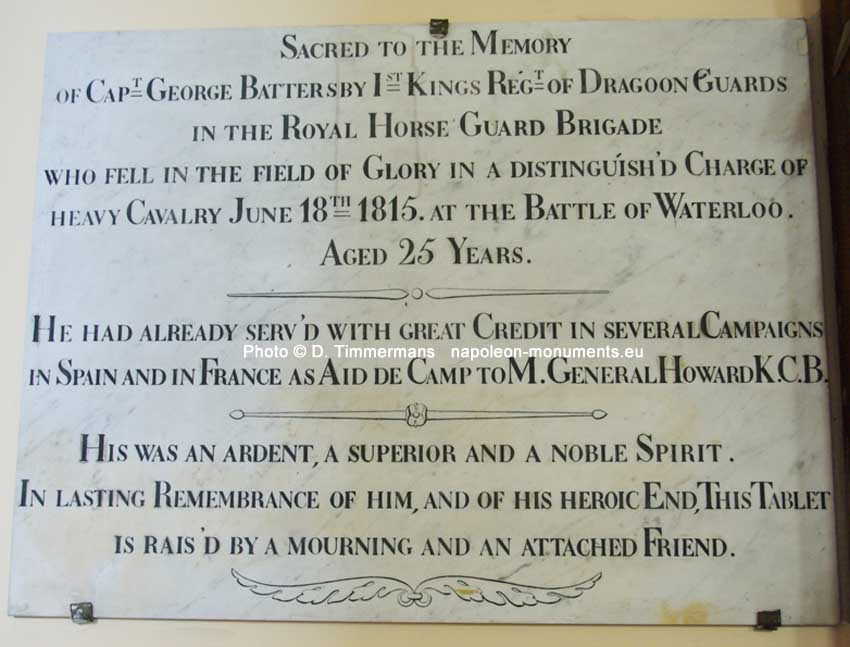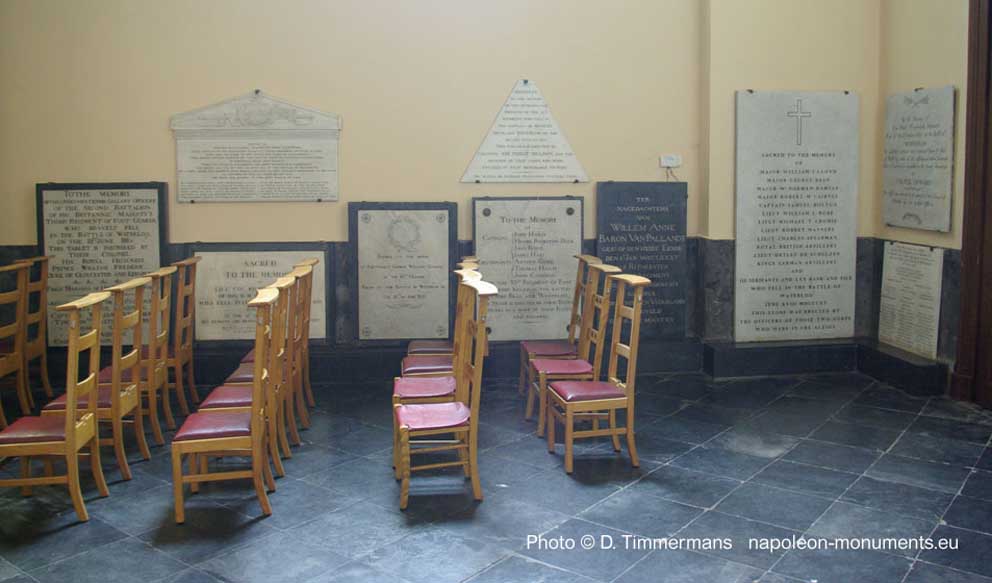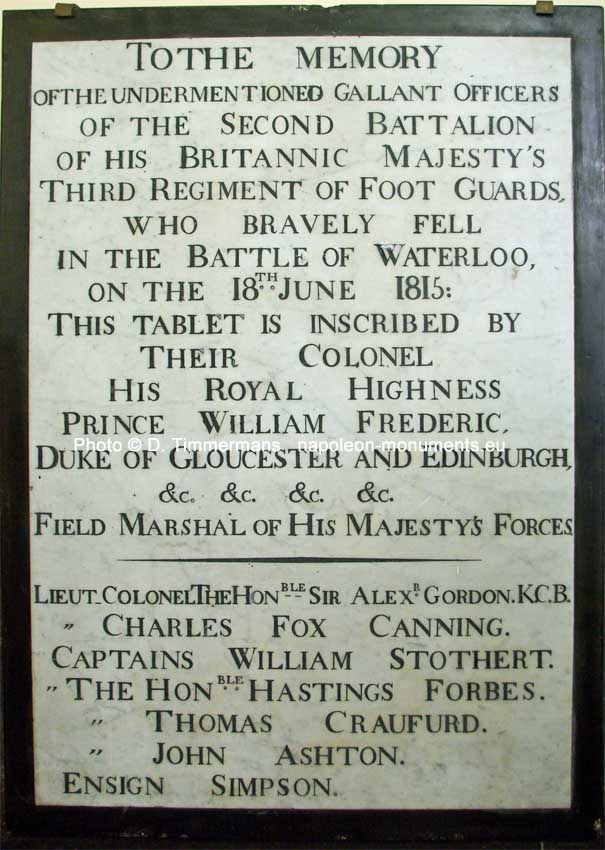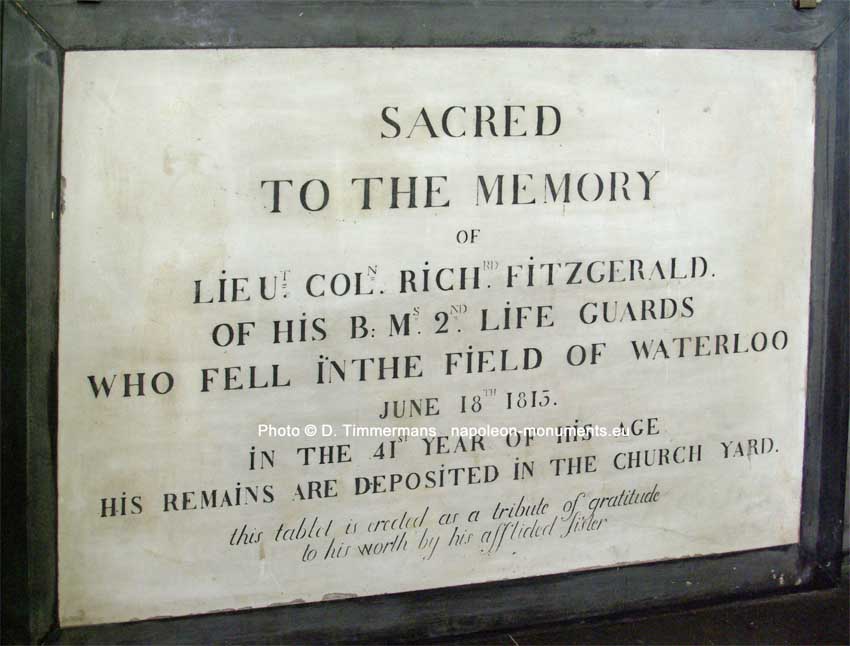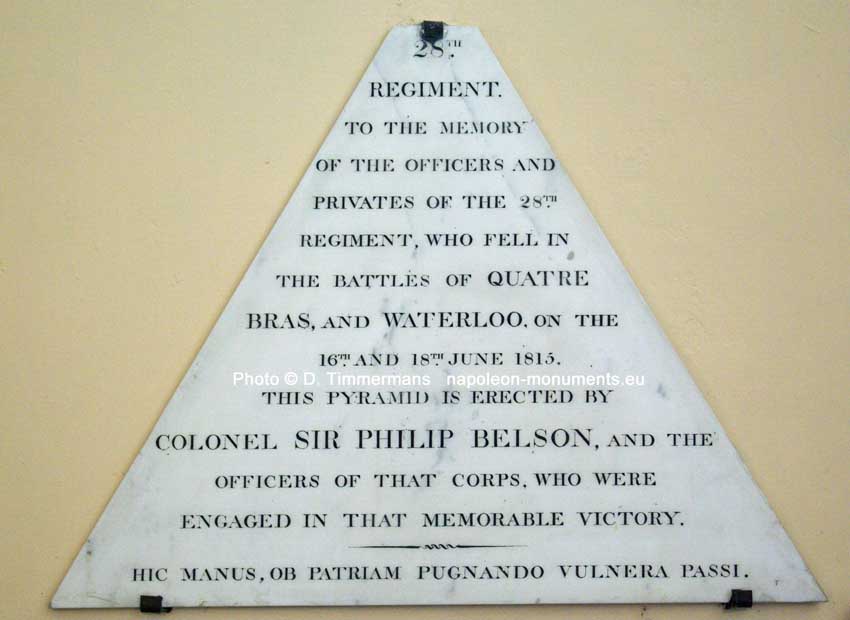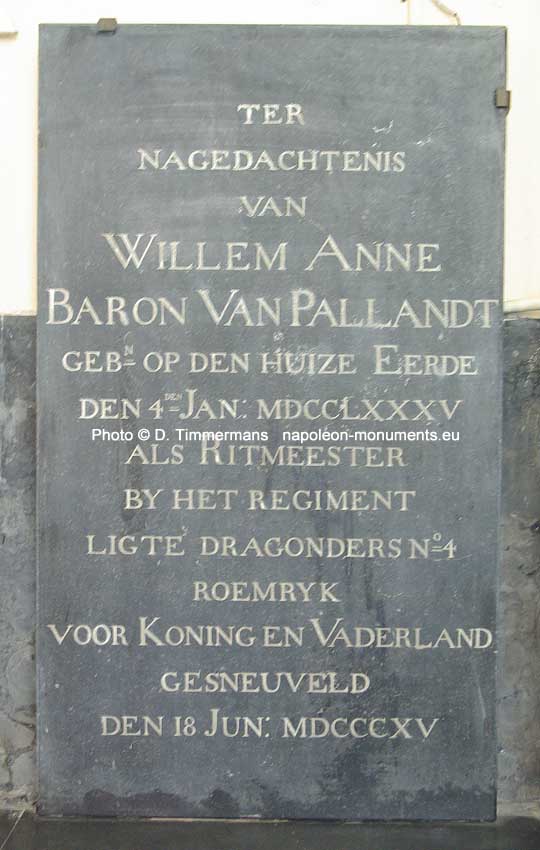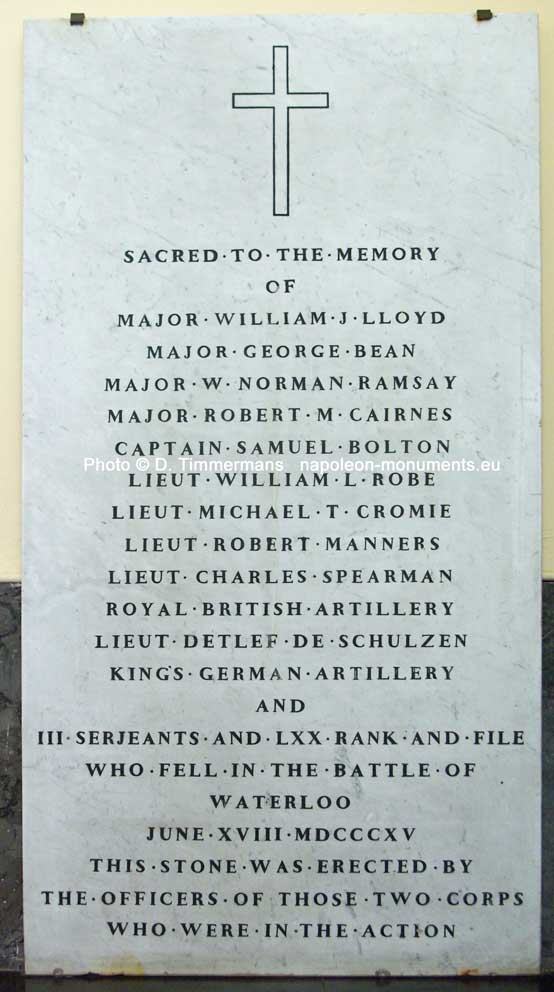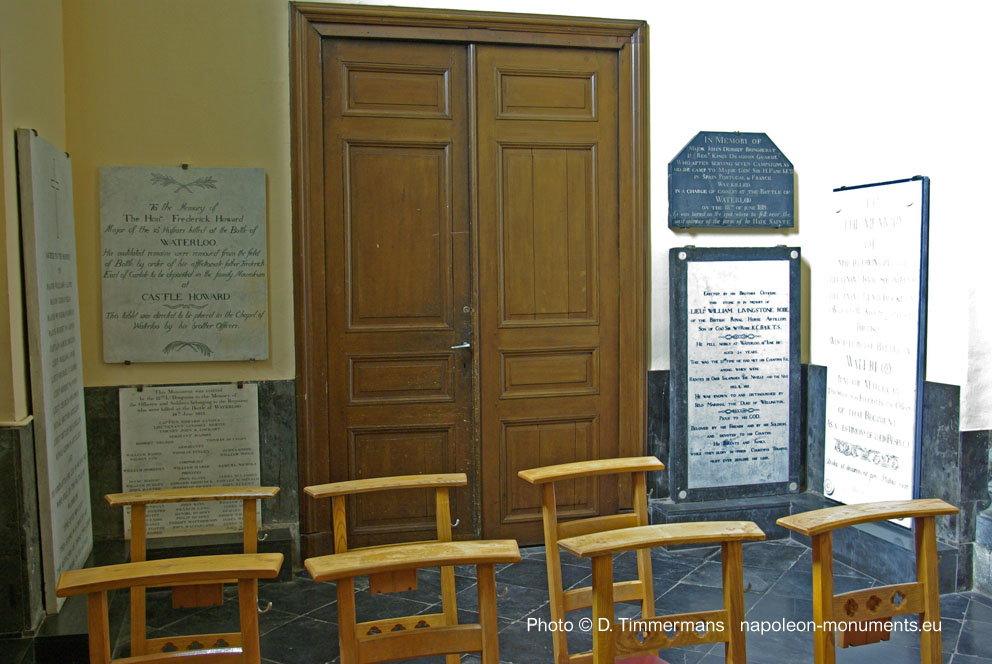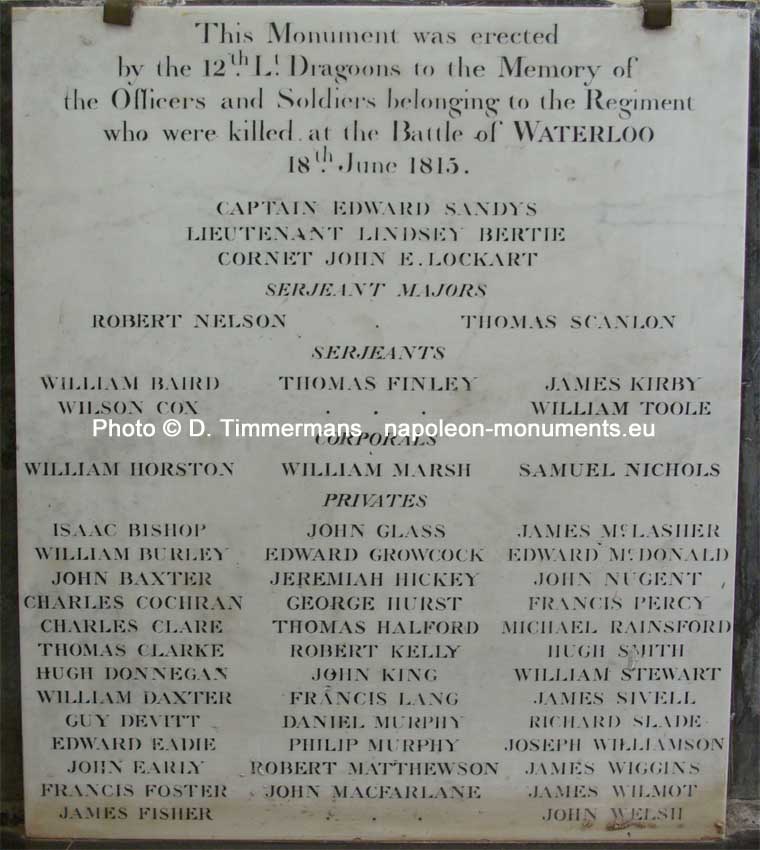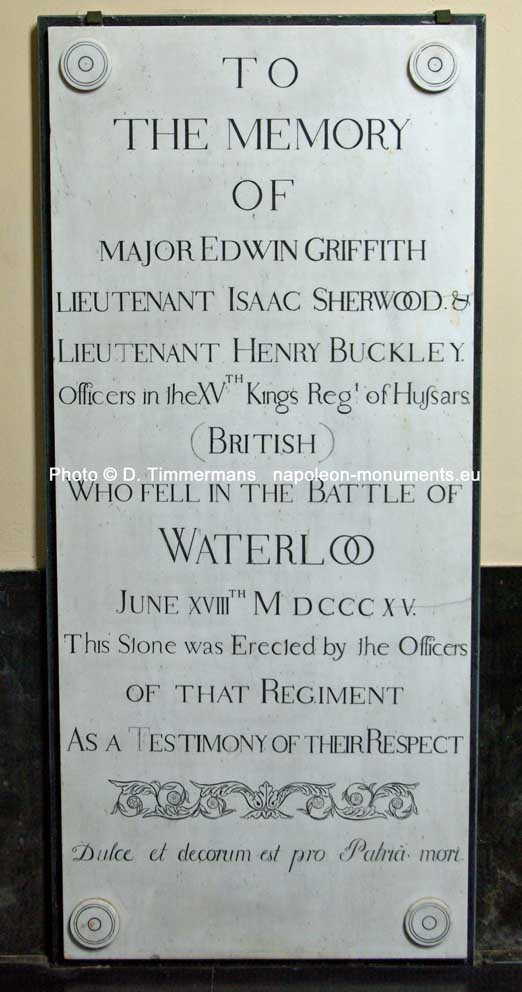The Royal Chapel and St-Joseph church of Waterloo
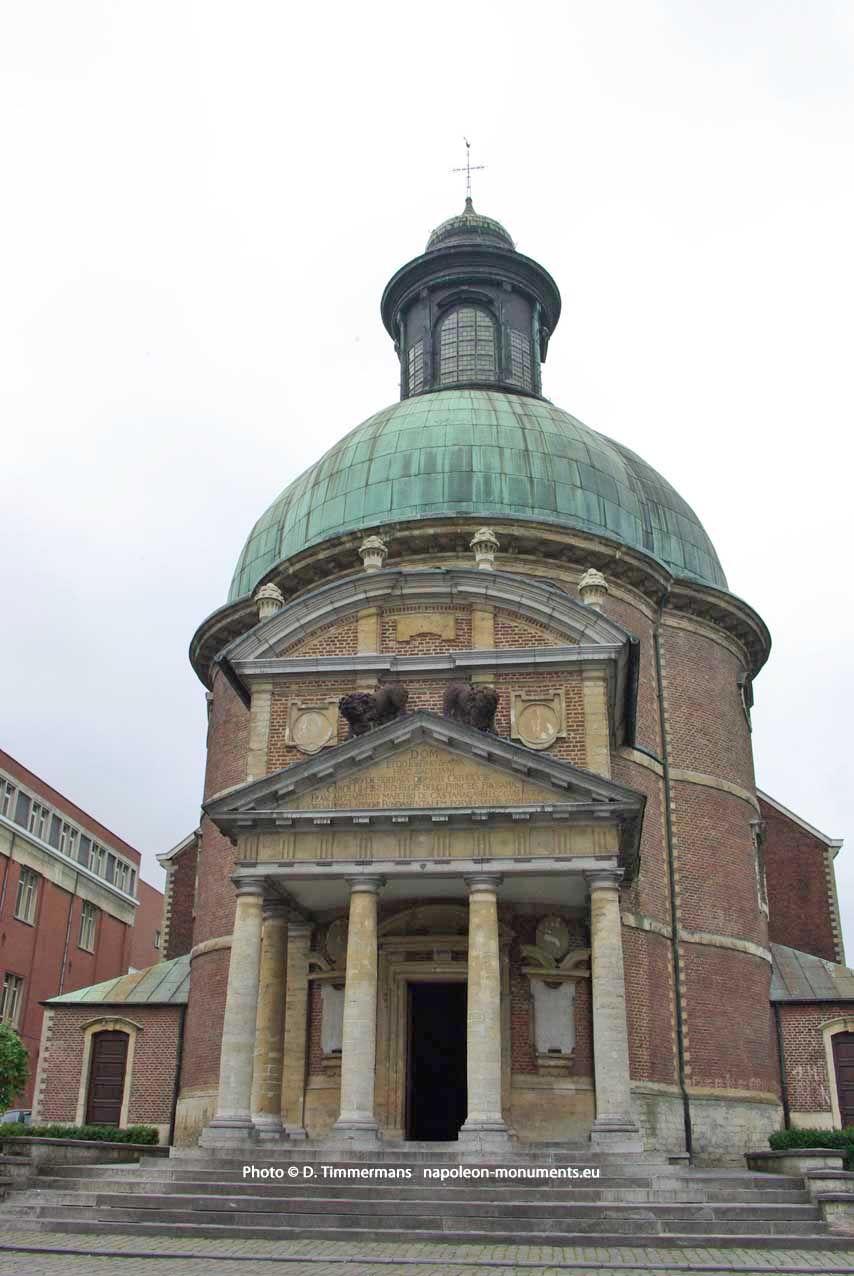
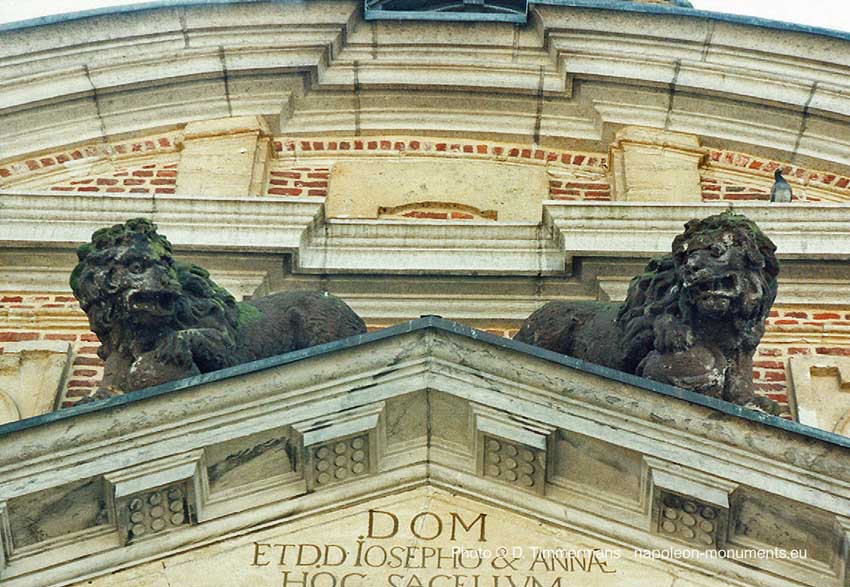
1) Monument to the British soldiers with a bust of the duke of Wellington
The Royal Chapel was built in the 17th Century. The name is a reference to the King of Spain. At first (see here), all the commemorative plaques where placed here; only later these plaques where transferred to the church. Only to memorials (the British and the Dutch one) remain in the chapel.
|
|
IN HONORED MEMORY OF
|
|
|
2) Monument to the soldiers of the Netherlands Army
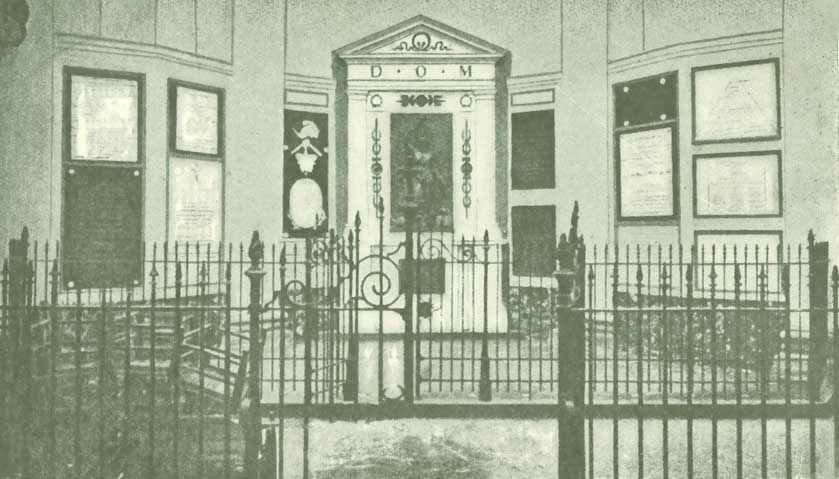
Ancient view of the Chapel, with the plaques still in place. Maybe some of
these don't exist any more.
Only one, the one to the 28th
Foot, can clearly be identified at the right top.
|
|
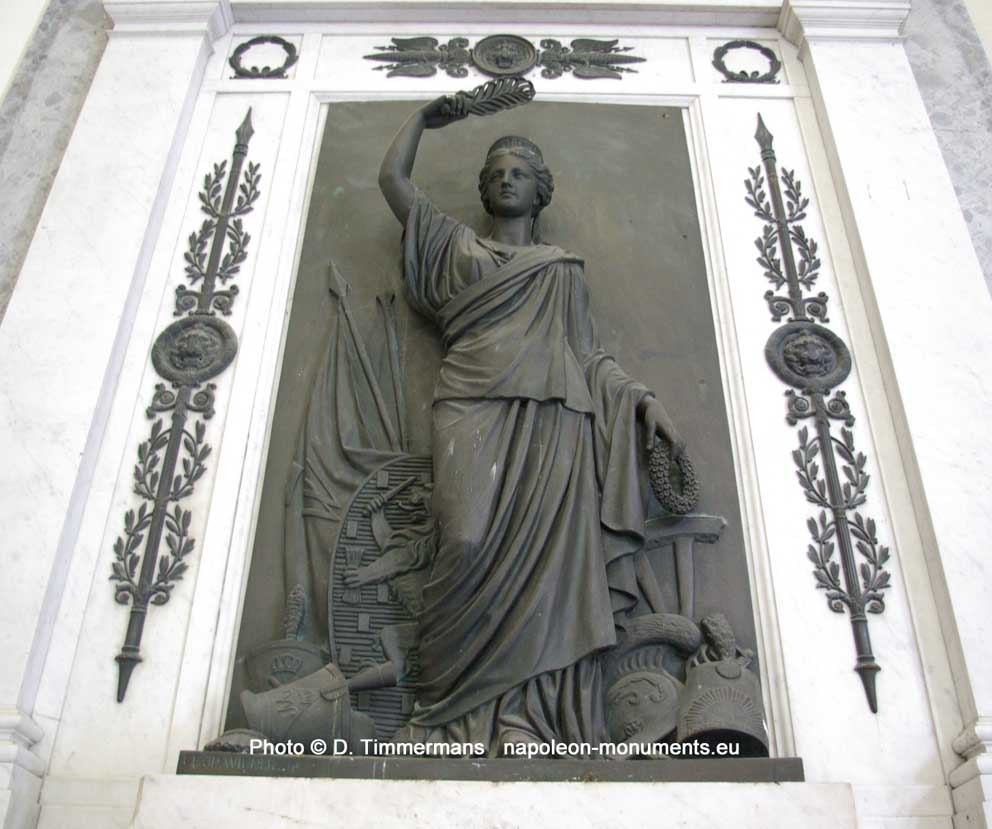
 |
Auspice illustrissimo principe
|
Under the patronage of the most illustrious Prince Frederic
of Nassau,
this monument was erected for the eternal memory of the
remarkable victory of 18 June 1815
by the financing and care of his
brothers in arms of Waterloo.
B) Inside the St-Joseph church

A complete visit of the commemorative plaques in the church, beginning with the left side aisle .
|
|
Click on the picture and you will immediately be taken to the plaque.
|
The plaques to general Van Merlen and to Major Ramsey are behind this (nearly always closed) door.
1) Plaque to the officers, non-commissioned officers and soldiers of the 2nd Battalion/30th Foot killed at Waterloo
|
|
Sacred |
2 ) Plaque to Cornet Alexander Hay, of the 16th Light Dragoons
|
Sacred
This Tablet was placed here by his |
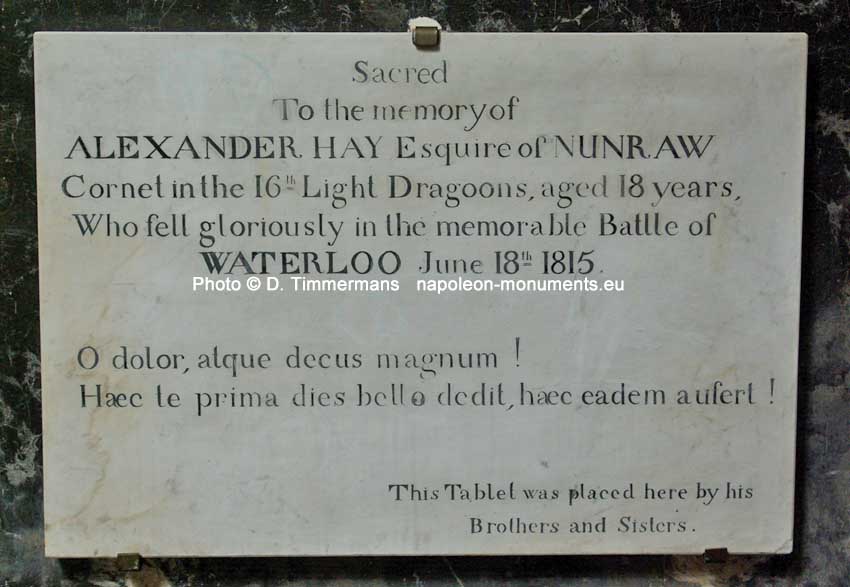 |
Born 6th Sept., 1796. Of Nunraw, 3rd son of Robert Hay of Drumelzier, by Janet, eldest daughter of James Erskine, of Cardross. He joined his regiment on 11 November 1813. *
3) Plaque to the officers of the Army of the Netherlands killed at Waterloo
|
|
NEDERLANDSCHE OFFICIEREN
|
Even if the plaque mentions "Nederlandse" (i.e. Dutch) officers, I
preferred to write "from the Army of the Netherlands", because the
word "Dutch" is confusing. Indeed, the officers of Belgian regiments
are also mentioned here. One will take notice of the fact that
SLt
Pierre-Eugène d'Astier, of the 2nd Carabiniers, who died of wounds in July 1817,
is not mentioned on the plaque.
Lieutenant van Haren and
Ritmeester (cavalry Capt) W.A. Baron Van
Pallandt Van Eerde each have an individual plaque in this church.
Major de Villers, of the 8th (Belgian) Hussars, was born on 3 March 1772 at Herbigny,
near Rethel... in France. He was mortally wounded by a shrapnel that hit
him on the right side of his breast. He died of his wounds on Tuesday 20
June 1815 and was buried in the cemetery at Waterloo.
Further reading :
Claude Van Hoorebeeck, Les deux seuls enterrements dans le cimetière de Waterloo d'officiers tués lors des combats du 18 juin 1815 : le major baron Charles de Villers et le lieutenant colonel Richard FitzGerald, bulletin de la Société belge d'études napoléoniennes, n° 51, décembre 2007, pages 43 à 57.
4) Plaque to the officers of the Army of the Netherlands killed at Quatre-Bras
|
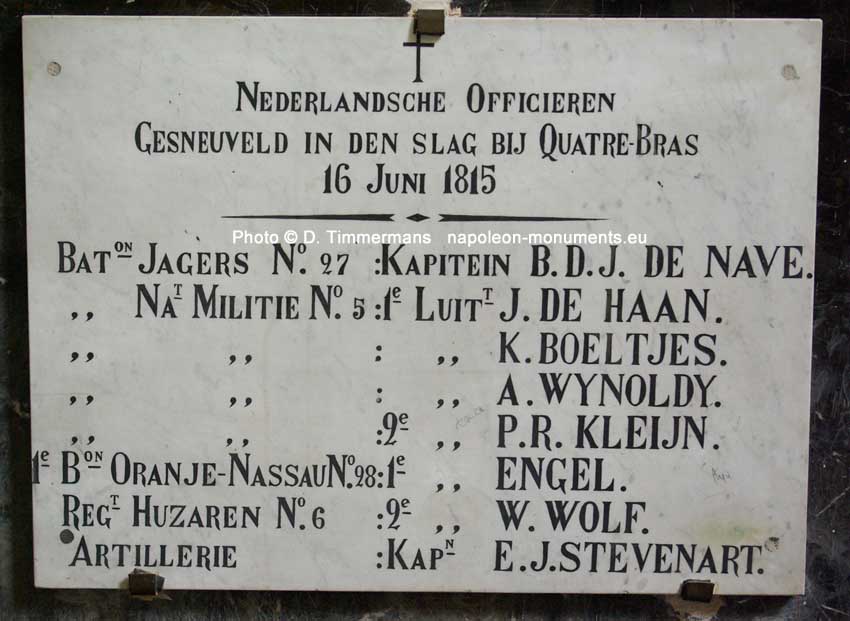 |
Emmanuel-Joseph Stevenart was born at Orbaix (now part of Perwez, in Walloon Brabant) on 6 (or 8) June 1785, and had begun his career in the 8th Artillery regiment on the 1st of October 1805. Becomes corporal on May 1st, 1807, sergeant on 9 September 1807, and sergeant-major on 22 September 1810. Takes part in the campaigns in Russia and Saxony, where he is promoted to Second Lieutenant on 15 June 1813, and also in France in 1814. He was allowed to leave the French army on the 9th July 1814.
When he gets home, he immediately joins the army of the Southern Netherlands and gets the rank of captain. At the Battle of Quatre-Bras, he was commander of a Foot Artillery battery when he was killed by the explosion of a French shell.
1st Lieutenant Everaert Engel was buired in the cemetery of Ways (Genappe),
like general
Duhesme, but unfortunately,his tomb was lost.
5) Plaque to 1st Lieutenant Claude François Sd van Haren
|
|
|
His third Christian name could be Sigismond. Van Haren is the first name on the plaque to the fallen of Waterloo.
6) Plaque to the officers of the 6th Dutch Hussars
|
de heeren officieren van het Regement Hussaren
n°6
Hun, die voor het Vaderland in 't
harnas zijn gestorven |
 |
Cornelis Breda is the only one not mentioned on the plaques to the fallen of 16 and 18 June. Maybe because he was just an ensign ?
Click on the picture and you will immediately be taken to the plaque. |
|
7) Plaque to the officers and non-commissioned officers of the 3rd battalion of the Royal Scots Regiment killed at Quatre-Bras and Waterloo
|
|
|
8) Plaque to the officers of the 1st Regiment de Foot Guards killed at Quatre-Bras and at Waterloo
|
Sacred
The Officers of
the |
|
To find out more about LtCol John William Miller :
A la recherche de la
tombe du colonel John William Miller, blessé le 16 juin, aux Quatre-Bras,
par Claude Van Hoorebeeck.
His tomb still exist in the Evere
Cemetery.
A recent ceremony on his tomb : here.
About Stables, go here, and here.
About Milnes,
Grose,
Brown,
Hay,
Barrington.
All of these Officers are commemorated on the Guards Officers Memorial at the
Royal Military Chapel, Wellington Barracks.
9) Plaque to Colonel Sir Henry Walton Ellis, of the 23rd Royal Welsh Fusiliers
|
|
|
Much more about Sir Walton Ellis here.
10) Plaque to the officers, non-commissioned officers and
soldiers of the 79th Regiment of Highlanders killed at Quatre-Bras and
Waterloo
|
Sacred to the memOry How sleep the
Brave who sink to rest ?
|
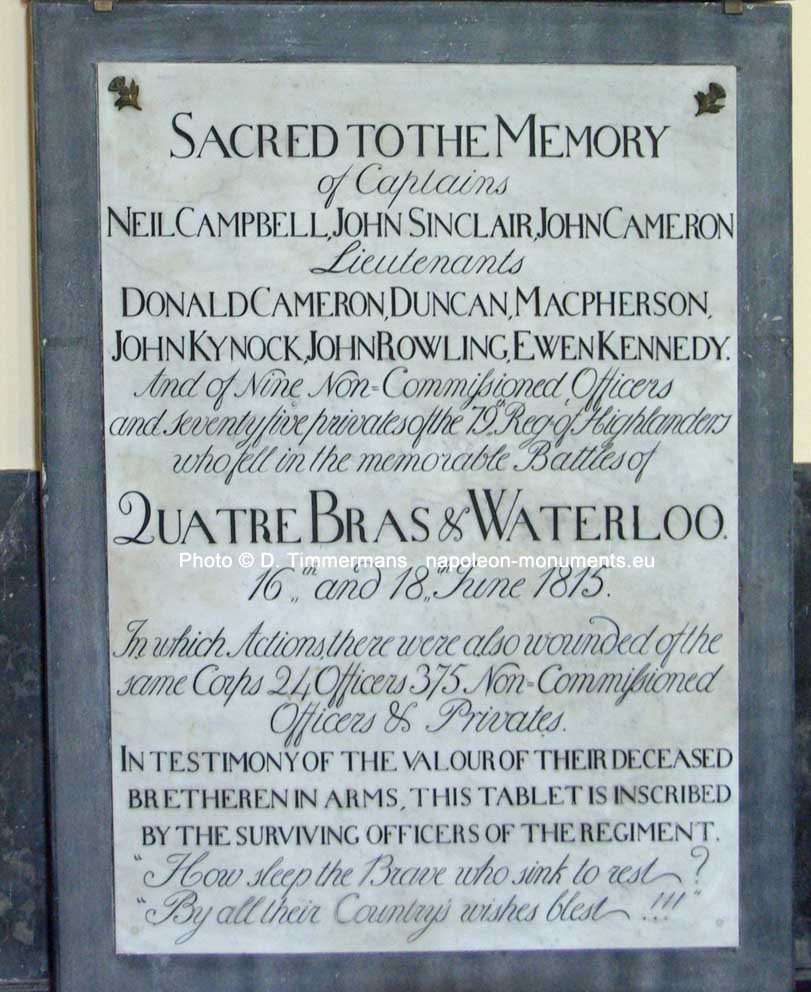 |
11) Plaque to the officers, non-commissioned officers and soldiers de la Grande Armée killed in June 1815
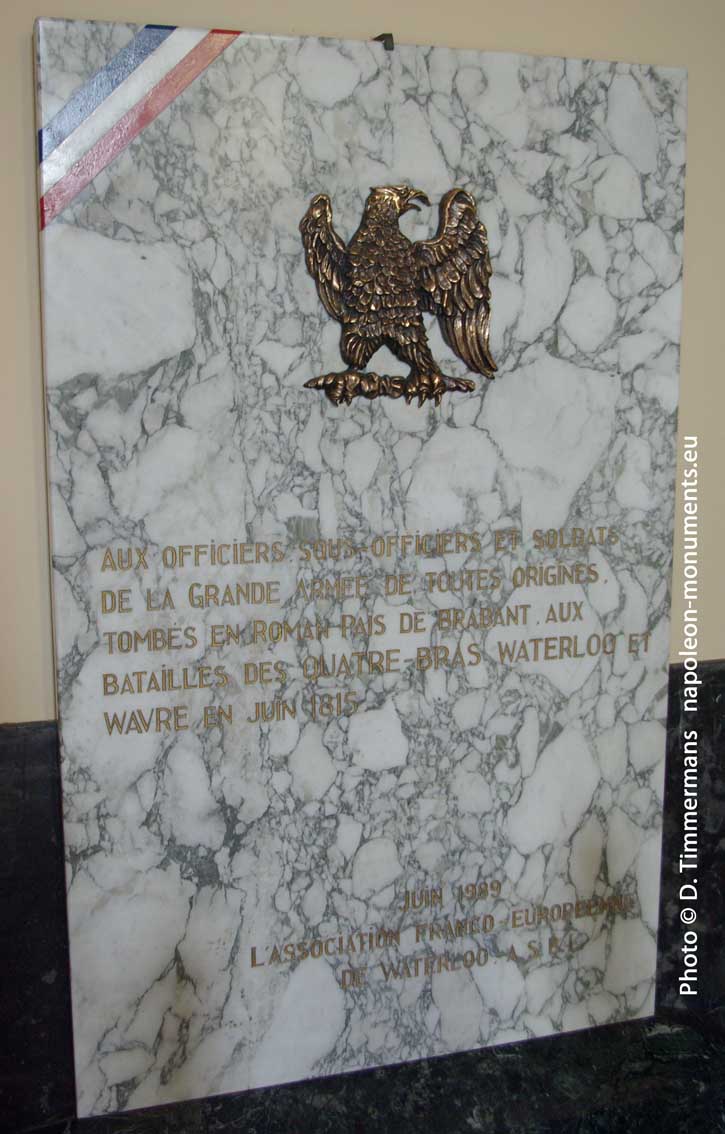 |
|
This plaque was unveiled on the 15 June 1990 by the Count du Cause de Nazelle, Ambassador of France, in presence of baron Gourgaud, president of the Souvenir Napoléonien, of count de Meeus d'Argenteuil, Intendant of the Duke of Wellington and many other personalities. Mgr Letourneur, president of the French Veteran Priests, said mass with M. Dereymaeker, the parish priest.
The term "Grande Armée" is not quite right here. It should be "Armée du Nord".
12) Plaque to Major Robert M. Cairnes, Royal Horse Artillery
|
|
|
Major Cairnes was the 2nd son of Maj. W. Cairnes, of 39th Foot, who served all
through the defence of Gibraltar, and who died in India. On the female side,
he was of the elder branch of the same family to whom a baronetcy was granted
by Queen Anne (extinct).
He had reached the rank of Captain on the 1st of February 1808. Cairnes had
seen much service in the Peninsula : from June 1810 till July 1811 (Cadiz,
Barossa, Seville) and from
June 1812 till August 1812, he had belonged to the 4th Company, 10 Bn., unit
which he commanded from September until February 1814 (Vitoria (Gold Medal),
Nivelle, Pyrenees (Gold Medal), Bayonne).
After that, he joined I
Troop, R. H. A.. He became brevet Major on 12th of April 1814
At Waterloo, he
was still a Captain and still belonged to the same unit, I Troop, under orders
of Major Bull. He was killed by a cannon ball.
There is of course mentioned on the Artillery memorial in this
church and he also has a memorial Canterbury Cathedral.*
13) Plaque to Colonel William Fuller of the 1st (or the King's own) Regiment of Dragoon Guards
|
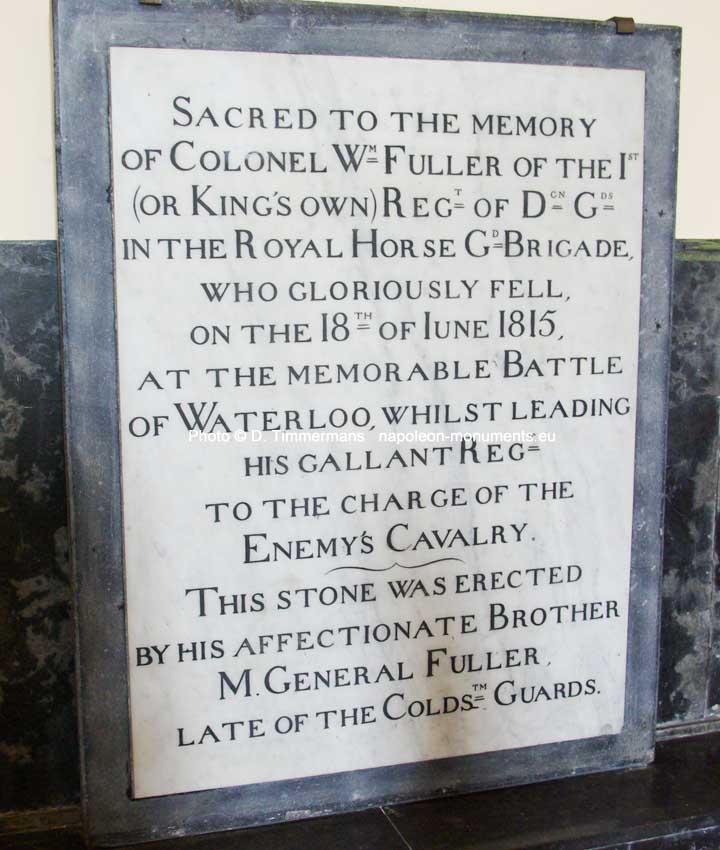 |
He had joined this regiment on 22 August 1805 and had become it's commander on 4 June
1813. Let us remind that this most prestigious regiment hadn't taken
part in the Peninsular War !
At Waterloo, he was still in command of this unit, belonging to the 1st
Cavalry
Brigade under Lord Edward Somerset.
14) Plaque to Captain George Battersby of the 1st Regiment of Dragoon Guards
|
|
Sacred to the memory |
Born on the 20th April, 1788. Youngest son of John Battersby, of the Westmeath
family. Captain on 2 September 1813. Fell in the last cavalry charge.*
15) Plaque to the Officers of the 7th (Queen's own) Hussars killed on 17 June 1815 at Genappe
|
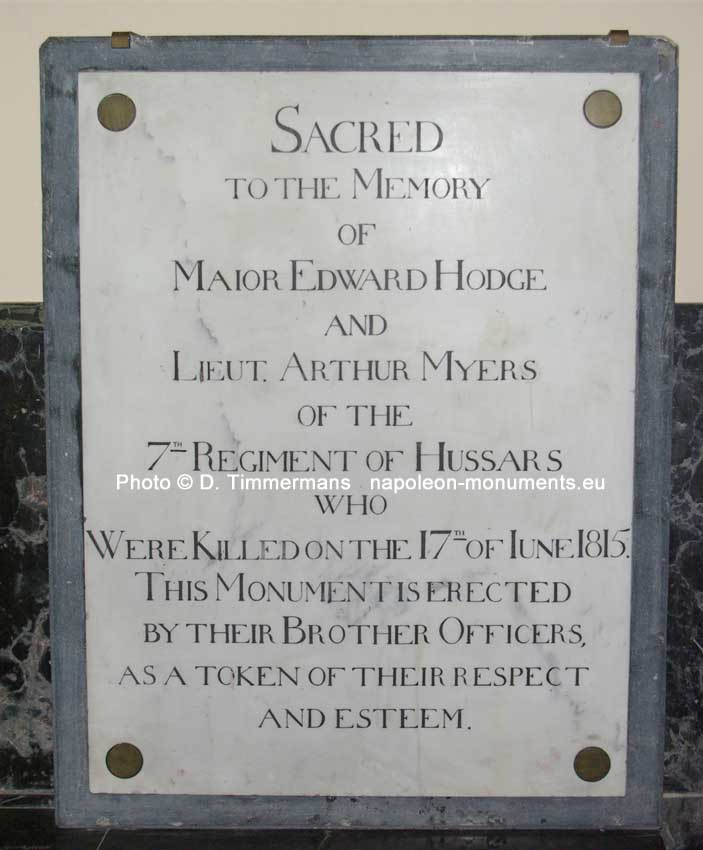 |
A pension of 100 Pound per ann. to his widow, who was younger daughter of Sir
Edmund Bacon, Premier Baronet.
Arthur Myers, Adjt., rank in the regiment : 24 May, 1810.*
The London Gazette lists them both as severely wounded, le Waterloo
Medal Roll mentions Myers as wounded and missing. The 7th Hussars is also Cotton's
regiment.
The plaques on the right side aisle, from left to right.
|
|
|
16) Plaque to the Officers of the 2nd Battalion / 3rd Foot Guards
|
|
|
Lt Col Sir Alexander Gordon, Lt Col Charles Fox Canning (see underneath) and Captain Thomas Craufurd are mentioned here.
All of these Officers are commemorated on the Guards Officers Memorial at the Royal Military Chapel, Wellington Barracks.
17) Plaque to Lieutenant-Colonel Charles Fox Canning, of the 3rd Foot Guards
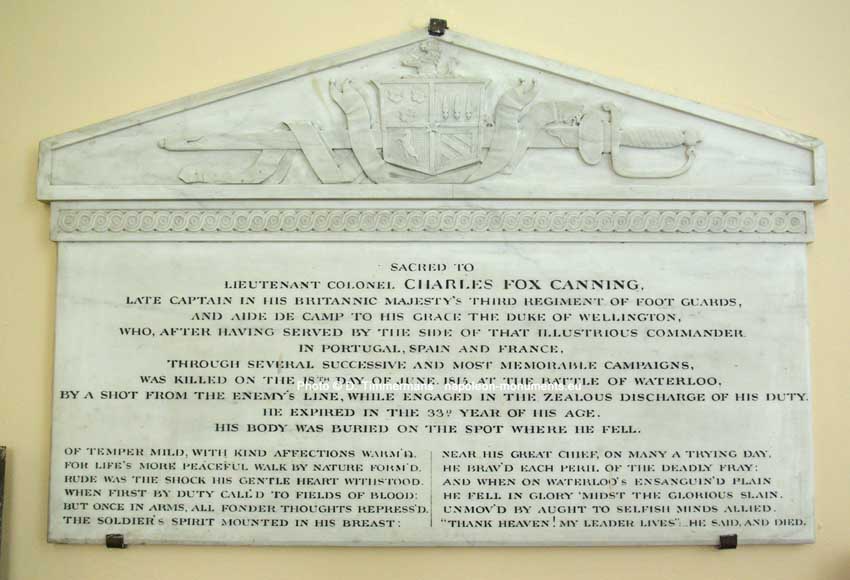
Sacred to
Lieutenant Colonel Charles Fox Canning
Late Captain in his Britannic Majesty's Third Regiment of Foot Guards,
and aide de camp to his grace the duke of Wellington,
Who, after having served by the side of that illustrious commander
in Portugal, Spain and France,
Through several successive and most memorable campaigns,
was killed on the 18th day of June 1815, at the battle of Waterloo,
by a shot from the enemy's line, while engaged in the zealous discharge of his
duty.
He expired in the 33d year of his age
His body was buried on the place where he fell.
|
|
Third son of Stratford Canning, by Mehetabel Patrick, of Summerhill, Dublin, and brother of the subsequently celebrated diplomatist, Viscount Stratford of Redcliffe.
3rd Foot Guards : Lt & Capt 25 December 1807, Capt & Lt-Col 31 March 1814
Had acted as A.D.C, to Wellington in the Peninsula, from May 1809 until April
1814 (Talavera, Bussaco, Fuentes de Oñoro, Badajoz, Ciudad Rodrigo, Badajoz,
Salamanca, Burgos, Vitoria, Pyrenees, Bidassoa, Nivelle (Gold Medal), Nive
(GM), Orthez (GM), Toulouse (GM)) and it was by the former's special request
that the Duke took him again on his personal staff just before Waterloo.*
He is commemorated on the Guards Officers Memorial at the Royal Military Chapel, Wellington Barracks.
18) Plaque to Lieutenant-Colonel Richard Fitzgerald of the 2nd Life Guards
|
|
|
More about Lieutenant-Colonel Richard Fitzgerald
And even more:
Claude Van Hoorebeeck, Les deux seuls enterrements dans le cimetière de Waterloo d'officiers tués lors des combats du 18 juin 1815 : le major baron Charles de Villers et le lieutenant colonel Richard FitzGerald, bulletin de la Société belge d'études napoléoniennes, n° 51, décembre 2007, pages 43 à 57.
19) Plaque to Lieutenant George Orlando (William) Gunning of the 10th Hussars (10th (or the Prince of Wales's own Royal) Regiment of Light Dragoons (Hussars).
|
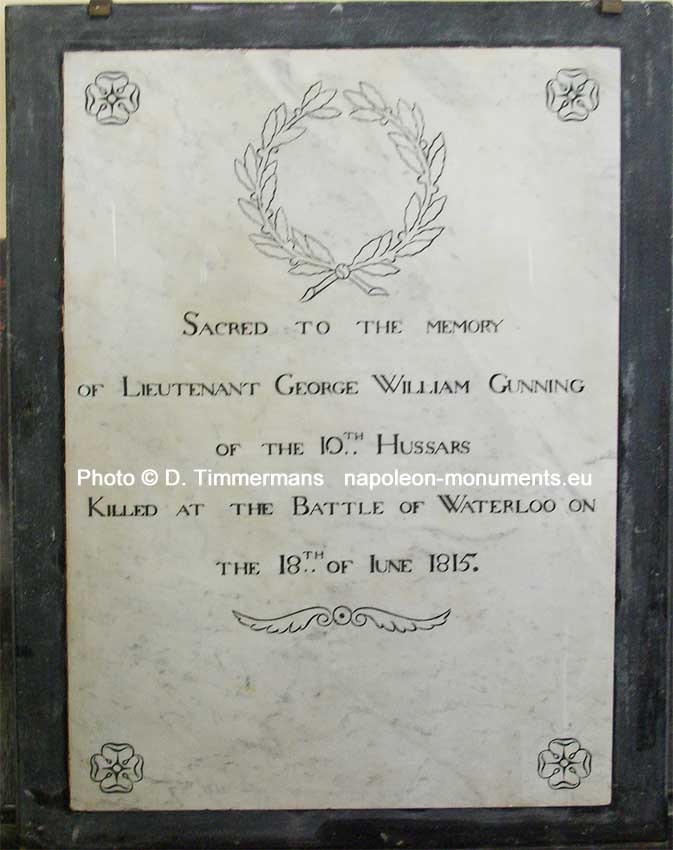 |
George Orlando (according to the Waterloo and the Peninsula Roll Call) or
William Gunning was born on the 18th December, 1796, second son of Sir George
Wm. Gunning, Bart., by Elizabeth, daughter of Henry, 1st Lord Bradford.
Took part in the campaign in Southern France in March and April 1814. Saw
action at Toulouse.
He had reached the rank of lieutenant in the 3rd Dragoons on the 8th April
1813 and entered the 10th Hussars on 26 December 1814.*
20) Plaque to the officers, non-commissioned officers and soldiers of the 28th Regiment of Foot killed at Quatre-Bras and Waterloo
|
|
|
21) Plaque to the officers of the 33rd Regiment of Foot killed at Quatre-Bras and at Waterloo
|
|
22) Plaque to Ritmeester baron van Pallandt, of the 4de Regiment Lichte Dragonders
|
|
|
He is also mentioned on the plaque to the fallen of 18 Junen.
23) Plaque to the officers, non-commissioned officers and soldiers of the Royal British Artillery and the King's German Artillery killed at the battle of Waterloo
|
Sacred to the memory |
|
Robert M. Cairnes has a personal memorial in this church. Lieutenant Carl von Schulzen is mentioned on the Hanoverian monument at la Haie-Sainte.
|
|
Click on the picture and you will immediately be taken to the plaque. |
24) Plaque to Major Frederick Howard of the 10th Hussars (10th (or the Prince of Wales's own Royal) Regiment of Light Dragoons (Hussars).
|
 |
Third son of Frederick, 5th Earl of Carlisle, by Lady Margaret Granville-Leveson, daughter of 1st Marquis of Stafford.
Captain 11 January 1805. Major 9 May 1811.
Peninsular campaign from November 1808 to January 1809 and December 1813 to
April 1814.
Saw action at Sahagun, Benevente, Orthez and Toulouse.
Killed whilst gallantly leading the last charge. Buried at Waterloo.
Afterwards brought home and buried at Streatham, 3rd Aug., 1815. Left issue by
his marriage with Frances, only daughter of Wm. H. Lambton, of Lambton Hall,
Durham, two sons. In 1879, Maj. Howard's remains were removed from Streatham,
and re-interred in the family mausoleum at Castle Howard, Yorkshire.*
25) Plaque to the officers and soldiers of the 12th Light Dragoon killed at Waterloo
|
|
|
26) Plaque to Major John Dorset Bringhurst of the 1st (or the King's) Regiment of Dragoon Guards
|
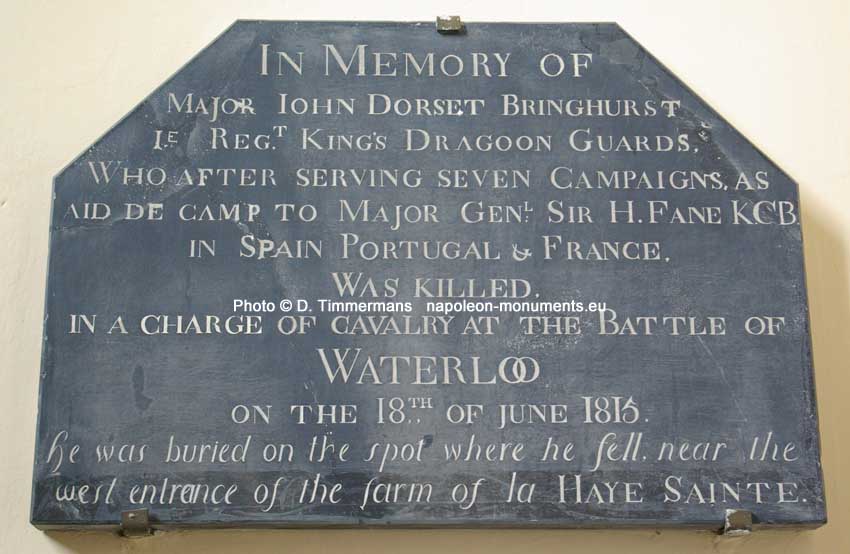 |
...the west entrance of the farm of la HAYE SAINTE...
From Woodstone, county of Huntingdon. Married to Frances Maria Bringhurst.
Captain in the regiment 24 October 1811, Major 12 April 1814.*
27) Plaque to Lieutenant William Livingstone Robe of the Royal Horse Artillery
|
|
|
He was buried in the Waterloo cemetery, but unfortunately,
his tomb has been lost.
28) Plaque to the Officers of the 15th Hussars
|
TO the Memory Of |
|
Griffith had become Captain on the 27th June 1805 and Major on the 5 November 1812.
He had participated in the Peninsular War from November 1808 to January 1809 (Corunna campaign) and February 1813 to April 1814 (Morales, Vitoria (G.M.), Orthez (G.M.), Toulouse).
The Waterloo Roll Call gives us this poem about Major Griffith :
" Weep not ; he died as heroes die,
The death permitted to the brave ;
Mourn not ; he lies where soldiers lie,
And valour envies such a grave.
" His was the love of bold emprise,
Of soldier's hardships, soldier's fame !
And his the wish by arms to rise,
And gain a proud, a deathless name."
Sherwood had joined the regiment on 4 October 1809. Lieutenant 13
September 1810.
He had served in the Peninsula from February 1813 to April 1814 (Morales,
Vitoria, Orthez, Toulouse).
Buckley had only joined the regiment on 25 August 1814.*
These two plaques are not in the church, but in what one could call the narthex,
behind the door on the left, in between the plaques to the
Dutch fallen and to Van Haren.
I wish to thank Mr Claude Van Hoorebeeck for the two following pictures.
29) Plaque to general van Merlen, commander of the Second
Light Cavalry Brigade of the Army of the Netherlands
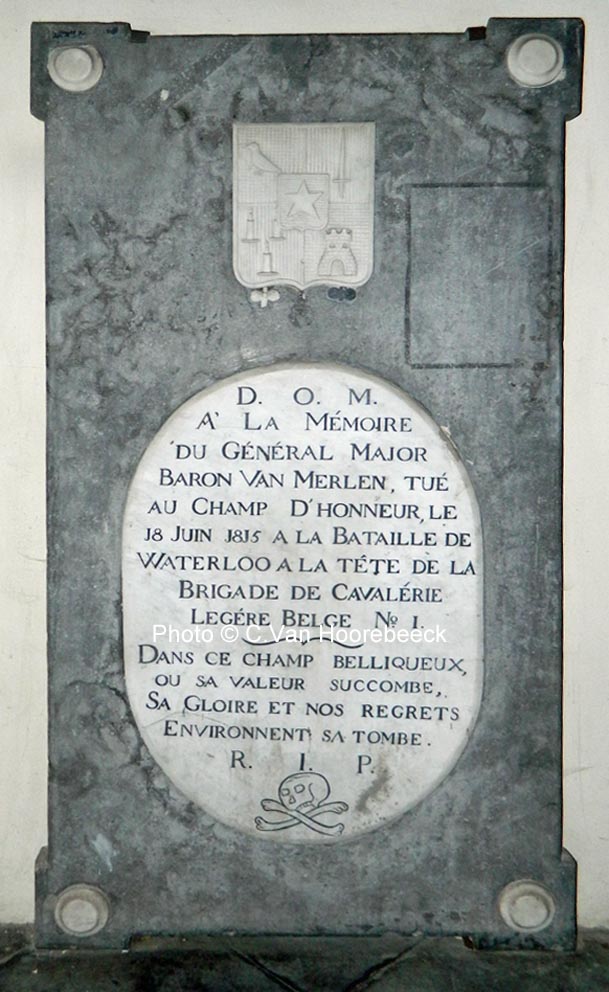 |
D.O.M. |
We shall write a page on Van Merlen soon. He is commemorated three times in the
church: on this plaque, on the one to the fallen of the 18
June and on the one of the 6th Dutch Hussars.
30) Plaque to Major William Norman Ramsay, de la Royal Horse
Artillery
|
@ |
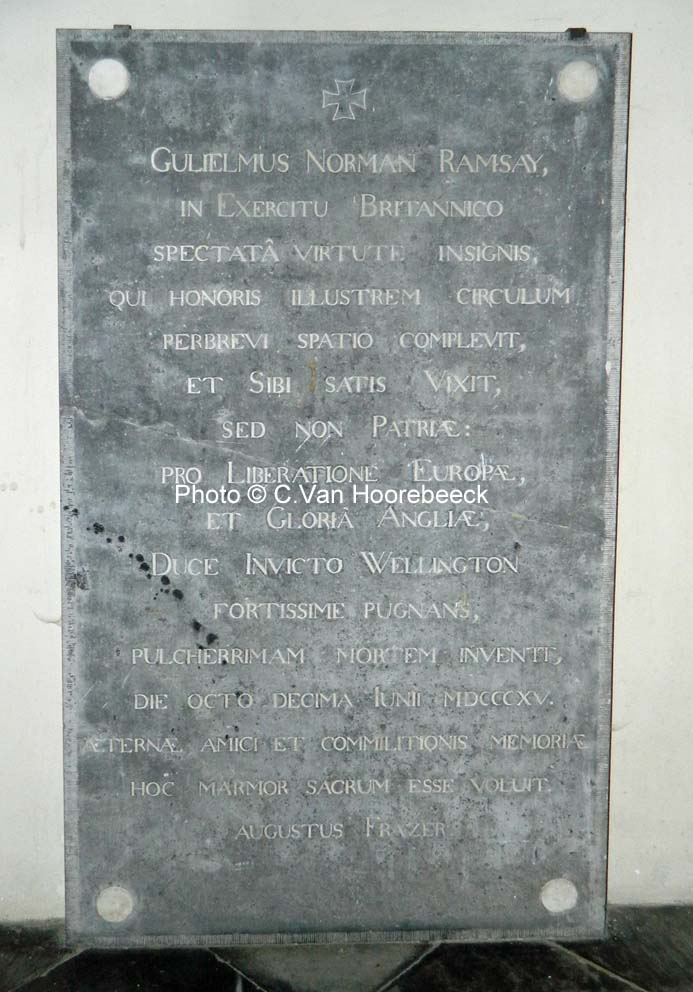 |
William Norman Ramsay, who was famous in the British Army for his proven
courage and who gained in a short time all honours and who lived enough for
himself, but not for his Country.
He met a beautiful death fighting bravely for the liberation of Europe
and the glory of England, under command of an unvanquished Duke of Wellington,
on the 18th June 1815.
[Sir] Augustus Frazer wanted to praise this sacred stone to the eternal memory
of his friend and brother in arms.
William Norman Ramsay's name has been immortalised by
Napier in his Peninsular War. He came of a Scottish family, and was the eldest
of three sons of a retired naval officer who resided in Edinburgh. He was the
pride and glory of the branch of the army to which he belonged, and the beau-ideal
of what a Horse Artilleryman should be. He served with great credit in Maj.
Bull's troop of R.H.A., in the Peninsula, from 1811 to 1813. It was in the
campaign of 1811 that he performed the brilliant action which Napier's facile
pen has so strikingly illustrated. This happened on 5th May, 1811, when, the
British cavalry out-guards being far outnumbered near
Fuentes de Oñoro,
were driven in upon their supports, and Capt. Ramsay found himself cut off. It
is a matter of history how Ramsay, at the head of his battery, charged like a
whirlwind through the French squadrons who intervened between his handful of
men and the British troops, and rejoined the latter in safety when given up
for lost. And at the battle of Vitoria,
Ramsay again distinguished himself, but, by an unfortunate act of disobedience
to Wellington's orders, he incurred the Iron Duke's iron displeasure. The
story has been told as follows by a well-known author, and differs somewhat
from the account given by Col. Duncan in his History of the Royal Artillery :
" I remember hearing a striking instance of what, perhaps, 'might be called
severe justice, which he exercised on a young and distinguished officer of
artillery in Spain ; and though one cannot help pitying the case of the
gallant young fellow who was the sacrifice, yet the question of strict duty,
to the very word, was set at rest for ever under the Duke's command, and it
saved much after trouble, by making every officer satisfied, however fiery his
courage or tender his sense of being suspected of the white feather, that
implicit obedience was the course he must pursue. The case was this : The army
was going into action. The Duke posted an officer, with his six guns, at a
certain point, telling him to remain there until he had orders from him. Away
went the rest of the army, and the officer was left doing nothing at all,
which he didn't like ; for he was one of those high-blooded gentlemen who are
never so happy as when they are making other people miserable, and he was
longing for the head of a French column to be hammering away at. In half an
hour or so he heard the distant sound of action, and it approached nearer and
nearer, until he heard it close beside him ; and he wondered rather that he
was not invited to take a share in it, when, pat to his thought, up came an
aide-de-camp at full speed, telling him that Gen. Somebody ordered him to
bring up his guns. The officer asked, ' Did not the order come from Lord
Wellington ?' The aid-de-camp said ' No,' but from the general, whoever he was.
The officer explained that he was placed there by Lord Wellington, under
command not to move unless by an order from himself. The aide-de-camp stated
that the general's entire brigade was being driven in, and must be annihilated
without the aid of the guns, and asked, "Would he let a whole brigade be
slaughtered ?" in a tone which wounded the young soldier's pride,
savouring, as he thought it did, of an imputation on his courage. He
immediately ordered his guns to move, and joined battle with the general ; but
while he was away an aide-de-camp from Lord Wellington rode up to where the
guns had been posted, and, of course, no gun was to be had for the service
which Lord Wellington required. Well, the French were repulsed, as it happened
; but the want of those six guns seriously marred a pre-concerted movement of
the Duke's, and the officer in command of them was immediately put in arrest.
Almost every general officer in the army endeavoured to get this sentence
revoked, lamenting the fate of a gallant fellow being sent away for a slight
error in judgment while the army was in full action ; but Lord Wellington was
inexorable, saying he must make an example to secure himself in the perfect
obedience of officers to their orders, and it had the effect." Mr. Lover's
Handy Andy. To a man of Norman Ramsay's highly honourable and sensitive nature
the circumstances of his arrest, coupled with the omission of his name from
the Vitoria despatches, and the loss of a brevet he had well earned, may be
said to have inflicted a wound which neither time nor subsequent honours could
heal. Three weeks after his arrest he was restored to the command of his
battery, to the great joy of the whole army in Spain, and after the battle of
the Bidassoa he was promoted bt. maj. At Waterloo, he commanded the H Troop R.H.A., and his forward gallantry in that battle attracted the fatal bullet
which put an end to his noble life. He was buried on the field by his great
friend Sir Augustus Frazer, during a momentary lull in the battle, but three
weeks later was disinterred and his body sent to Edinburgh, as the
only consolation to his aged father, half-demented with grief, who was fated to
lose his three gallant sons in the short space of eight months. Norman Ramsay
m., 14th June, 1808, Mary Emilia, eldest daughter of Lt.-Gen. MacLeod, of Macleod.
Sir Augustus Frazer erected the above monument to Ramsay's memory in the
church of
Waterloo (and not on the battlefield, as Dalton says). The hero's remains were subsequently interred in Inveresk Churchyard.*
Of course, William Norman Ramsay is mentioned on the plate to the dead of the Artillery. Lieutenant Robe belonged to his battery.
*
Most biographies were taken or compiled from :
- Dalton, Charles, The Waterloo Roll Call, with biographical notes and
anecdotes, Eyre and Spottiswoode, London, 1904.
and
- Challis, Lionel S. Peninsula Roll Call. 1949. The Napoleon Series.
December 2011. < www.napoleon-series.org >
------------------------------------------------------------------------------------------------------------------------------------------------------------------------------------------------------------------------------------------------------
Bibliography :
- An, The Waterloo Medal Roll, compiled from the Muster Rolls, The Naval and Military Press, 1992.
- Mark Adkin, The Waterloo Companion, Aurum Press, 2001.
- Alain Arcq, Les Quatre-Bras, le second prélude à Waterloo, in the collection "Les batailles oubliées", Historic'One Editions, 2005.
- Alain Arcq, Ligny, 16 juin 1815, La dernière victoire de l'Empereur, in the collection "Les batailles oubliées", Historic'One Editions, 2006.
- Alain Arcq, Wavre & le combat de Namur L'épilogue de la campagne de Belgique, in the collection "Les batailles oubliées", Historic'One Editions, 2008.
- Barral, Georges, Itinéraire illustré de l'épopée de Waterloo, guide
historique et militaire du champ de bataille, avec les diagrammes de l'auteur
et 60 dessins originaux d'Adolphe Hamesse. Flammarion, Paris, 1896.
- Alain CHAPPET - Roger MARTIN - Alain PIGEARD, Le Guide Napoléon - 4000 lieux
pour revivre l'épopée, Bibliothèque Napoléonienne, Tallandier, 2005.
- Dalton, Charles, The Waterloo Roll Call, with biographical notes and
anecdotes, Eyre and Spottiswoode, London, 1904.
- Yann Deniau et Yves Moerman, 1815 - Napoléon en Campagne,
Jourdan éditeur, 2008.
- Peter Hofschröer, Waterloo 1815 - Quatre-Bras & Ligny, Pen & Sword, 2006.
- Peter Hofschröer, Waterloo 1815 - Wavre, Plancenoit & the race to Paris, Pen & Sword, 2006.
- André Sevrin and Alain Arcq, Route Napoléon 1815 (ouvrage collectif coordonné par), Edition Unité de projet "Route Napoléon 1815", s.d..
- G. Speeckaert and I. Baecker, Les 135 vestiges et monuments
commémoratifs des combats de 1815 en Belgique, Waterloo, relais de
l'histoire, 1990. Exists also in English.
- Mr. Claude Van Hoorebeeck's website :
http://www.freepub.be/waterloo.php
- Van Neck, Léon, Waterloo met afbeeldingen, Lebègue, Brussel, s.d (around 1905).
